As quietly as I can, I raise my binoculars. All I can make out is a silhouette against the starlit sky, perched on the side of a spruce. With each series of hoots (CD3-71), the owl’s whole upper body becomes swollen. Two pale marks appear just below the lower edge of the facial disk, like a silver torc on a Celtic chieftain’s neck. The torc appears to bounce with each hoot, staying visible through the whole series. As the last hoot fades away it settles and virtually disappears.
CD3-71: Lapland Owl Strix lapponica Västmanland, Sweden, 23:30, 30 March 2006. Hooting of a male. 06.004.MR.01120.22
A branch moves over to my right and I see the female perched on a dead tree in the open. When she hoots quietly, her timbre is strikingly different, almost growling (CD3-72). Soon she takes off and flies across to her mate with surprisingly audible wingbeats. The male responds with a different kind of hooting, a very deep pulse of about 3 hoots/sec at an even pitch. Shortly after joining him, the female gives two series of low-pitched chittering sounds. I suspect a nest, and with a little effort I find one.
CD3-72: Lapland Owl Strix lapponica Västmanland, Sweden, 23:30, 30 March 2006. Hooting of a female once, then wingbeats as she flies left, with pulsed hooting of male. Ends with some chittering calls of the female, by this time on the nest with the male. 06.004.MR.01745.02
Håkan has been listening to ‘Lappugglar’ Strix lapponica since before I was born. By the time I went to meet him in Sweden in 2012 he was in his 70s. He had been working hard on the paintings for this book, and I was looking forward to seeing them and offering some feedback. I hoped that we might also do some fieldwork, but I was not sure whether Håkan would still have much appetite for it. As it turned out he was better prepared for adventure than I. We spent three nights in the woods and only looked at his paintings on the last day.
In 2012, Lapland Owls were being seen in unusual places, often far from known breeding areas. Sometime after midwinter the vole population had taken a nosedive. In late March, Håkan had seen a minimum of 10 in one evening near Söderhamn, a coastal town 300 km north of Stockholm. By mid-April many had died and others had melted back into the forests where they were less conspicuous. We did twitch one, but sadly for me it remained silent. Breeding would be impossible with so little to eat.
Ural Owls S uralensis are less dependent on voles so we focussed on them instead, visiting several hotspots that Håkan knew well. When his imitations failed to draw a single response, we decided to sleep for a few hours and try again in the hours before dawn. Since we were still on location, I left my recorder working outside.
It was a treat to listen to those recordings later. The skies were full of migrating waterbirds, and several species of mammal called during the night. I am still at a loss to explain why, at the lowest point in the vole cycle while others were dying of hunger, one female Lapland Owl hooted while we slept. Later that spring, birders only found one Lapland nest in the entire country, a long way from where we had been (Stefansson 2013). Our female only hooted three times in eight minutes so just for once, I decided to shorten the gaps (CD3-73).
CD3-74: Lapland Owl Strix lapponica Möklinta, Uppland, Sweden, 02:20, 18 April 2012. Hooting of a distant female. The gaps have been shortened considerably. Background: Whooper Swan Cygnus cygnus, migrating Water Rail Rallus aquaticus, and Tawny Owl Strix aluco. 120418.MR.022033.33
Lapland Owls hoot differently from all other Strix owls. Most other species have a diagnostic compound rhythm consisting of one or more introductory notes followed after a gap by a larger cluster of terminal notes (Robb et al 2013). The hoo…..(very long gap) hu – hohohohooooooo of Tawny Owl S aluco is a classic example. With its simpler hoots, Lapland sounds closer to Short-eared Owl Asio flammeus. Surprisingly perhaps, it sits comfortably in the middle of the Strix phylogenetic tree, on a branch slightly older than that leading to Tawny and Ural Owl (eg, Wink et al 2009).
Lapland Owl’s other kind of hooting is more typically Strix. I call it pulsed hooting (Robb et al 2013). In CD3-71, this was the deep, continuous throbbing by the male when the female flew towards him. There he gave 50 hoots in a row, but Wahlstedt (1969) has reported up to 100. CD3-74 is a slightly clearer recording of this sound, but it will always be a difficult one to hear in the field. Not only is it quiet, it is also very low-pitched, carrying about 50 m at most (Wahlstedt 1969); in the Western Palearctic only Turkish Fish Owl Bubo semenowi can hoot this low.
CD3-74: Lapland Owl Strix lapponica Västmanland, Sweden, 23:30, 30 March 2006. Pulsed hooting of a male and soft growls of a female. 06.004.MR.05110.21
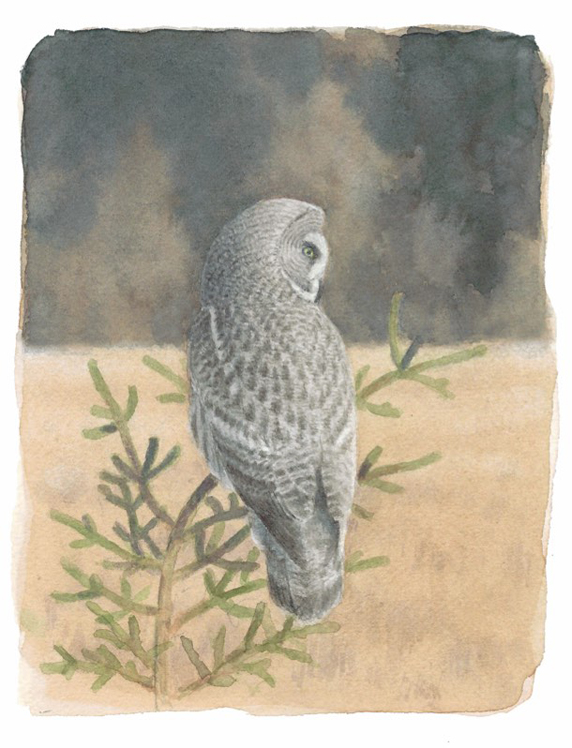
Håkan Delin
Pulsed hooting plays an important role in nest-showing. Males also use it in response to rivals (Lindblad 1967), and to stimulate females to accept food, especially if other sounds fail to elicit a response (Stefansson 1997). Sometimes male-female duets of pulsed hooting may arise. CD3-75 starts with a female, joined a few seconds later by a male.
Great Gray Owl S nebulosa lives, as its spelling suggests, in North America. Darker than Lapland Owl, it has bars and not just streaks on its underparts. Nevertheless, Great Gray looks so Lapland-like that few have ever questioned their usual treatment as subspecies. Great Gray was described for science first (Forster 1772), after the Scottish naturalist Andrew Graham discovered it at Fort Severn, Ontario (Nero 1982, Mikkola & Sieradzki 2012). It was only 26 years later that Carl Peter Thunberg, an apostle of Linnaeus, published his formal description of Lapland Owl. Based on a 3.31% difference in mtDNA (Johnsen et al 2010), Great Gray and Lapland parted company roughly 1.7 million years ago. Even if this estimate is wrong, they have not been in touch for a long time.
Many authors assume that Great Gray Owl and Lapland Owl sound alike, and combine voice descriptions from both continents indiscriminately. CD booklets often fail to mention in which continent recordings were made. Two recent owl CDs even publish the same fake interaction between a male and female, made up of a male Great Gray and a female Lapland mixed into a single track, with poorly disguised transitions back and forth (Pelz 2008, track 56, Harvancik 2009, track 73). To draw my own conclusions, I have only used recordings of known provenance, including those from the Macaulay Library, Ithaca, New York, USA, but also from various audio publications and websites. Several friends kindly gave me access to their unpublished recordings. Joseph Medley sent me many recordings of yosemitensis, a new subspecies of Great Gray recently described from California, USA, on purely genetic grounds (Hull et al 2014).
Initially, I could not hear any difference between territorial hooting of Great Gray Owl and Lapland Owl. When I analysed hooting from seven male Great Gray and 16 male Lapland, some subtle differences emerged. In Great Gray, the mean number of hoots in a series was greater, at 11.4, compared to 9.7 in Lapland, but there was plenty of overlap. It was only when I stopped measuring and just listened that I noticed something more consistent. In five of the seven Great Gray, each series started with a strikingly lower-pitched hoot that was usually the weakest of the whole series. The volume was then sustained fairly evenly over the ensuing hoots before dropping again, often just slightly, at the end. In all 16 Lapland the first note was strong and the series reached full volume near the start, before tailing off gradually towards the end. The hooting in CD3-76 belongs to a 10-month old male Great Gray.
CD3-76: Great Gray Owl Strix nebulosa Fairbanks, Alaska, USA, 22:00, 8 April 1973. Hooting of a 10-month old male in captivity (picked up at two weeks of age after both parents had been shot; later released). Leonard J Peyton & The Macaulay Library at the Cornell Lab of Ornithology.
Female Great Gray Owls completely lack the growling timbre of female Lapland Owls. Their hooting is male-like but higher-pitched with longer notes and shorter gaps in between (Beck & Winter 2000, Rognan 2007). The slightly wavering quality of the female Great Gray in CD3-77 seems to be a peculiarity of this individual.
CD3-77: Great Gray Owl Strix nebulosa Union County, Oregon, USA, 20:00, 21 March 1990. Hooting of a female. David S Herr & The Macaulay Library at the Cornell Lab of Ornithology.
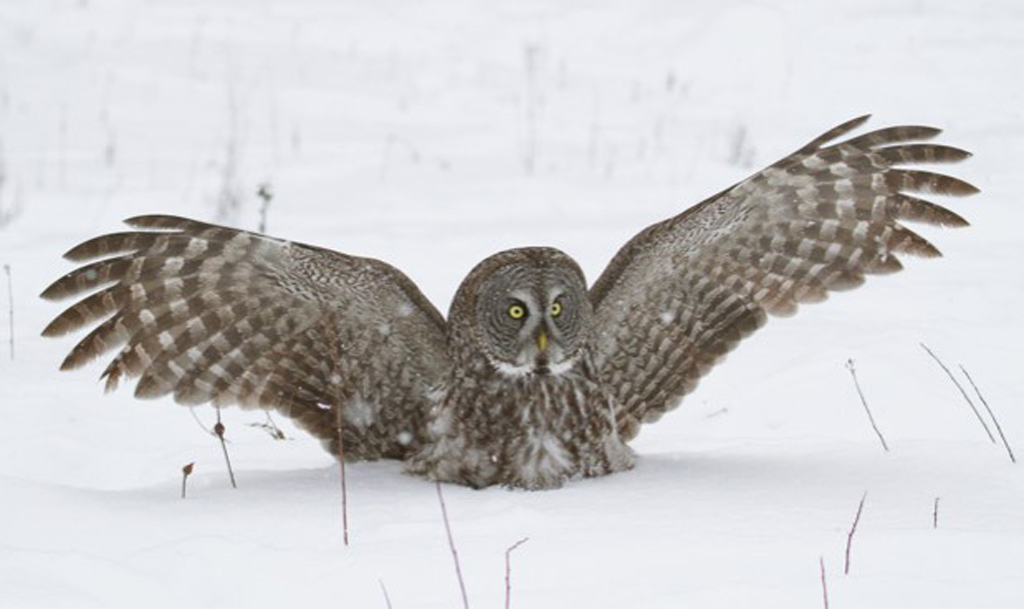
Great Gray Owl Strix nebulosa, Ontario, Ottawa, Canada, 31 January 2010 (Jo T Latham). Showing darker face and underparts than S lapponica, with streaking more suffused.
Pulsed hooting also differs noticeably between Great Gray Owl and Lapland Owl. In Great Gray Owl it goes by the name of ‘low double hoot’ (eg, Beck & Winter 2000). The repeated unit is actually a single hoot, usually with an accent at either end making it sound doubled (CD3-78). Females have similar but higher-pitched pulsed hooting. In either sex, the accents can be less clearly articulated and the hoots may not sound doubled, as shown by the female in CD3-79. Based on four males of each, Great Gray’s pulsed hooting is higher-pitched and slower with longer notes than Lapland’s. The maximum frequency in an entire series averaged 232 Hz in Great Gray but just 181 Hz in Lapland. Great Gray averaged 1.8 hoots/sec while Lapland averaged 2.8 hoots/sec. None of these measurements showed any overlap between the two species, but my sample was very small.
CD3-78: Great Gray Owl Strix nebulosa Roseaux, Minnesota, USA, 00:00, 13 May 1970. Pulsed hooting of a male. Background: frogs Anura. William W H Gunn & The Macaulay Library at the Cornell Lab of Ornithology.
CD3-79: Great Gray Owl Strix nebulosa Union County, Oregon, USA, 20:00, 21 March 1990. Pulsed hooting of a female. David S Herr & The Macaulay Library at the Cornell Lab of Ornithology.
The most striking vocal difference that I have noticed concerns soliciting calls and their juvenile equivalent, begging calls. Adult female soliciting calls are perhaps the commonest sound of Lapland Owl from a few days before egg-laying until the young are old enough to be heard from a distance. Stefansson (1997) describes Lapland’s soliciting call as a “weak treble hoot: Njeh, njeh, njeh”, audible from 100-300 m in forest but occasionally up to 600 m in open terrain.” Often the call may be just doubled as in CD3-80, or sometimes even given four times in quick succession. Single calls may occur from time to time but are never the rule. By contrast, the soliciting call of Great Gray Owl is nearly always a single whoop (CD3-81), often preceded by a very short, high-pitched upbeat. Great Gray’s whoop is longer than Lapland’s njeh, and I know of only one example where the whoop is briefly doubled in a long sequence of single calls (Macaulay Library 47532).
CD3-80: Lapland Owl Strix lapponica Siikajoki, Oulu, Finland, 22:55, 9 June 2003. Soliciting calls of a female. 03.010.KM.02520.32
CD3-81: Great Gray Owl Strix nebulosa Union County, Oregon, USA, 05:15, 12 May 1990. Soliciting calls of a female. Background: Black-capped Chickadee Poecile atricapillus, Fox Sparrow Passarella iliaca and Brown-headed Cowbird Molothrus ater. David S Herr & The Macaulay Library at the Cornell Lab of Ornithology.
When a male Lapland Owl arrives at the nest, he often gives a special ‘arrival hoot’ similar to his territorial hoot but without the early peak in volume and pitch; the energy is more evenly distributed through the series. Arrival hoots often have a certain roughness to them, inviting confusion with female hooting. In CD3-82, the female responds with a low-pitched chittering call. Both sexes may use this chittering as a ‘feeding call’ when offering food to small young, and the female also chitters during copulation (Mebs & Scherzinger 2004). In this recording one of the young also gives its own much higher-pitched, quieter chitter call.
CD3-82: Lapland Owl Strix lapponica Keminmaa, Lapland, Finland, 21:24, 5 June 2010. Low chittering of female, with arrival hooting of male. The higher-pitched chittering belongs to a juvenile. Background: Common Wood Pigeon Columba palumbus, Willow Warbler Phylloscopus trochilus, Song Thrush Turdus philomelos, Redwing T iliacus and European Robin Erithacus rubecula. 100605.DF.212400.01
The young in CD3-83 were a couple of weeks older. Outside the nest but still unable to fly, they were at their most vulnerable. Mark was also feeling vulnerable when he recorded them. While Killian changed position several times, capturing sounds of the same owlets and their mother from a variety of angles, Mark stayed put. It didn’t take long for the mosquitoes to find him. At one point he asked Killian, “Are you getting bitten?” When Killian lied, “No,” Mark suffered even more. The begging calls in Mark’s recording are like a higher-pitched version of adult soliciting calls (cf, CD3-80). The repetition separates them not only from Great Gray Owl but more usefully from Ural Owl (cf, CD4-10), which often lives in the same habitat.
CD3-83: Lapland Owl Strix lapponica Siikajoki, Oulu, Finland, 23:00, 9 June 2003. Begging calls of two young out of the nest but still unable to fly. Background: Common Cuckoo Cuculus canorus and Pied Flycatcher Ficedula hypoleuca. 03.023.MC.04100.21
Mark was lucky that mosquitoes were the worst of his woes. Breeding Lapland Owls are highly aggressive and can cause serious injuries. Even juveniles on the forest floor, still unable to fly, can lunge at the eyes of a photographer going in close for a wide-angle shot (Stefansson 1997). When you consider how vulnerable they are in this situation, such defences are understandable.
Young Lapland Owls will generally attract attention by calling but in case they are silent, an adult distraction display may betray their presence. If necessary the adult will moan, grunt and squeak while flapping wildly and feigning injury, positioning itself in a way that should lead the intruder away from the young. If this fails to work the owl, usually a female, changes strategy to aggression.
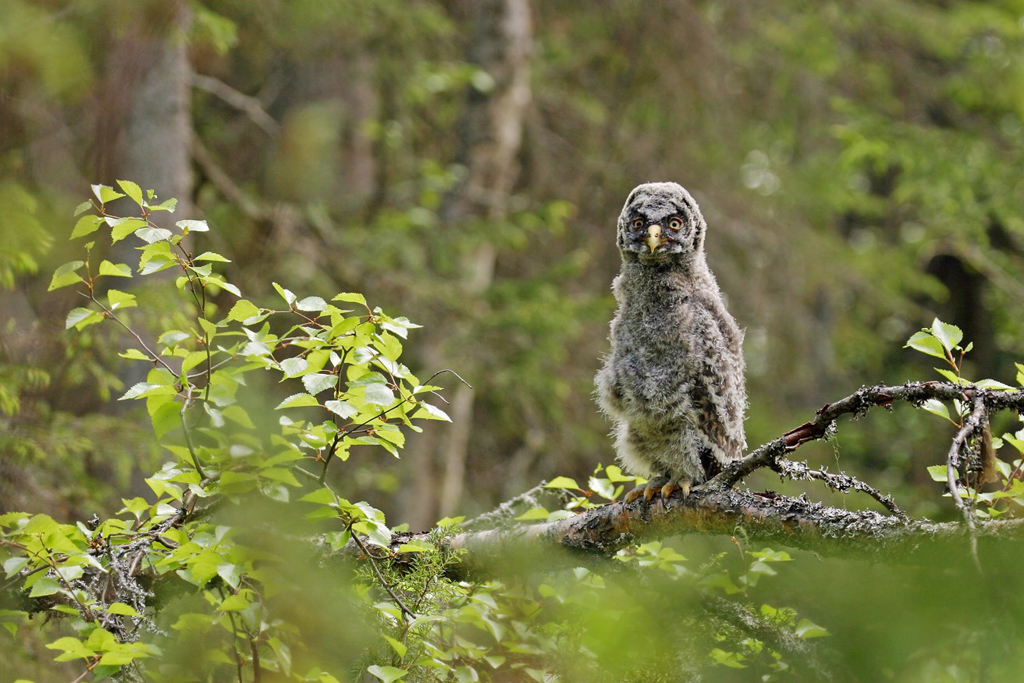
Lapland Owl Strix lapponica, fledgling of c 4 weeks of age, Pyhänta, Oulu, Pohjanmaa, Finland, 11 June 2003 (Dick Forsman). About same age as in CD3-83.
The signs to look out for are loud bill-snapping and growling with a deep, grainy voice that Håkan likens to a grand piano being pushed across the floor. When the bill-snapping becomes faster or louder, watch out! Crouching forward, lowering her wings and raising her scapulars, the owl shifts from foot to foot on the branch, fixing you with an intense stare. If one of the young bill-snaps too, her attack is guaranteed (Stefansson 1997). Pouncing forward, gliding on rigid wings, she thrusts her legs forward at the last moment with claws open, like a White-tailed Eagle Haliaeetus albicilla catching a fish. The impact can actually knock a man over (Nero 1982). Attacks are at their worst when food levels are high and the young are still unable to fly.
Outside the breeding season Lapland Owls are almost indifferent to humans, so we can watch them without concerns for either our safety or theirs. Listening to a vole munching vegetation under thick grass or snow, they may not even look at us. That would mean losing their fix on the vole, which depends on the orientation of the sound-gathering facial disk. The eyes go where the disk points since, unable to move in their sockets, they are effectively locked to the owl’s ears. One side of the disk is slightly higher than the other. The ears are positioned at different heights, allowing greater accuracy in the vertical plane when fixing the position of a sound.
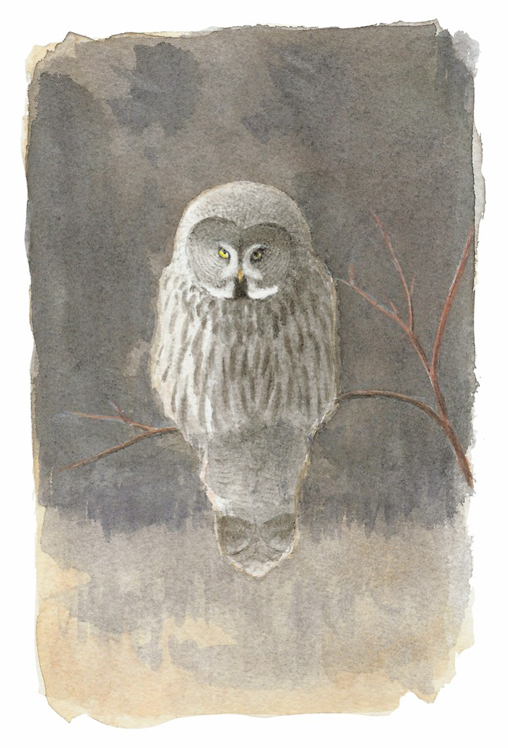
Håkan Delin
In CD3-84, voles are squabbling about 2 m away underneath a thick mat of last year’s grass, which has only recently emerged from a heavy blanket of snow. A Lapland Owl would hear them not only from tens of metres further away but also under half a metre of snow. After fixing the location, it could punch a hole in the snow so deep that it might even disappear from view completely. This is probably the key adaptation that allowed Lapland to live further north than any other Strix owl.
CD3-84: voles Arvicolinae (probably Field Vole Microtus agrestis or Water Vole Arvicola terrestris) Västmanland, Sweden, 16:47, 18 April 2012. Voles squabbling under a thick mat of grass. Background: Common Blackbird Turdus merula, European Robin Erithacus rubecula, Great Tit Parus major and Common Chaffinch Fringilla coelebs. 120418.MR.164710.21
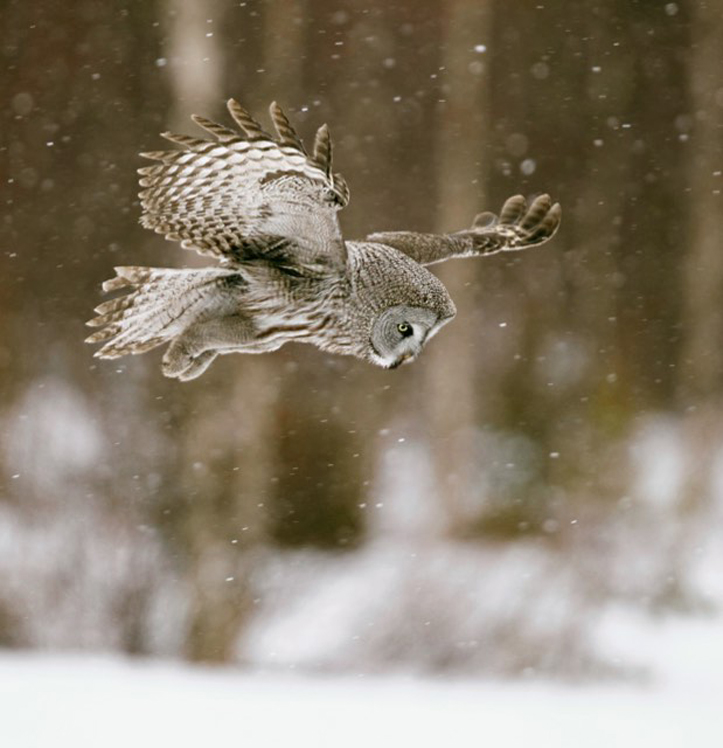
Lapland Owl Strix lapponica, Rovaniemi, Lapland, Finland, 6 May 2012 (Dick Forsman)
Although their lives revolve around voles, Lapland Owls are much less nomadic than Tengmalm’s Owls, which have more difficulty in penetrating the snow. Lapland usually stay on territory from one year to the next, often despite low vole numbers. Juveniles normally disperse very short distances, and one female bred in her own birth nest the next summer (Stefansson 1997). During peak vole years Lapland Owls may call during autumn and winter (Berggren & Wahlstedt 1977), but they tend to be much quieter at that season than other Strix owls.

Håkan Delin
When voles become extremely scarce, Lapland Owls of any age may leave their familiar territory and go in search of food. They never come back. 390 recoveries from the Swedish ringing program have led to this and many other insights. Most are recovered less than 100 km away, and there is no clear pattern regarding direction. The data do not support the idea that Lapland Owls noticed in central and even southern Sweden during vole crashes come from the north. Stefansson (2013) believes most birds ‘invading’ in 2012 for example came from the same province or one adjacent to where they were found. There may be far more breeding in southern Scandinavia than birders currently realise. In recent years, the isolated population in northern Ukraine and Belarus also spread rapidly south and west, with first nests found in eastern Poland in 2010 (Ławicki et al 2013).
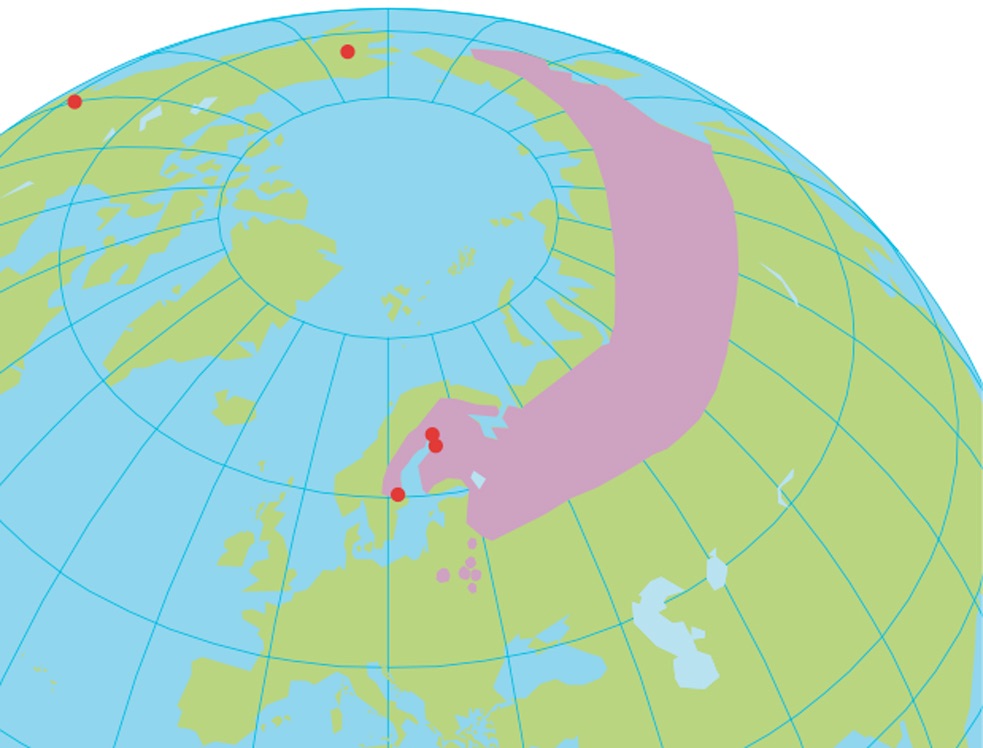
Approximate breeding distribution of Lapland Owl Strix lapponica (pink) . Recording locations of Lapland and Great Gray Owl S nebulosa (in North America) indicated by red dots.
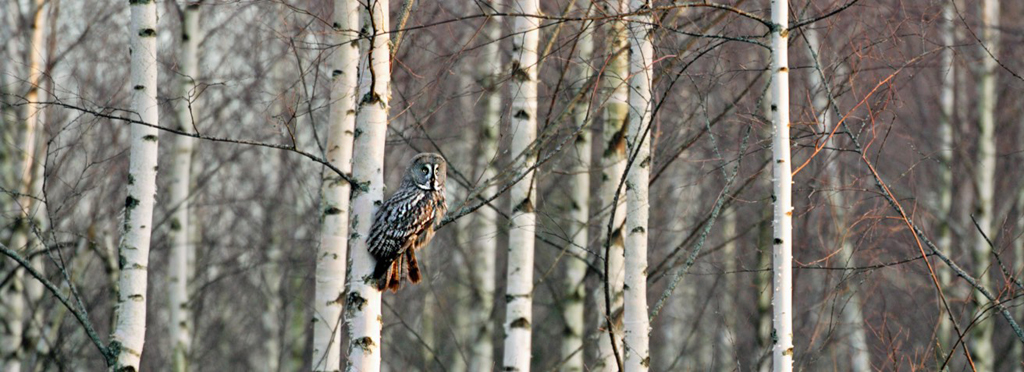
Lapland Owl Strix lapponica, Hyvinkaa, Uusimaa, Finland, 3 January 2007 (Dick Forsman)
Periodic episodes of nomadism have kept Lapland Owl’s genes well-mixed, and there is only one subspecies across the vast Palearctic taiga belt. In all but the northernmost reaches of this vast range it lives alongside a slightly smaller Strix owl that shows much greater variation in response to local conditions. Several of its subspecies are pale, almost angelic-looking, an appearance that could hardly be more deceptive.
